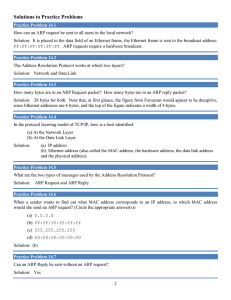Cisco – Chapter 11 - YSU Computer Science & Information Systems
advertisement
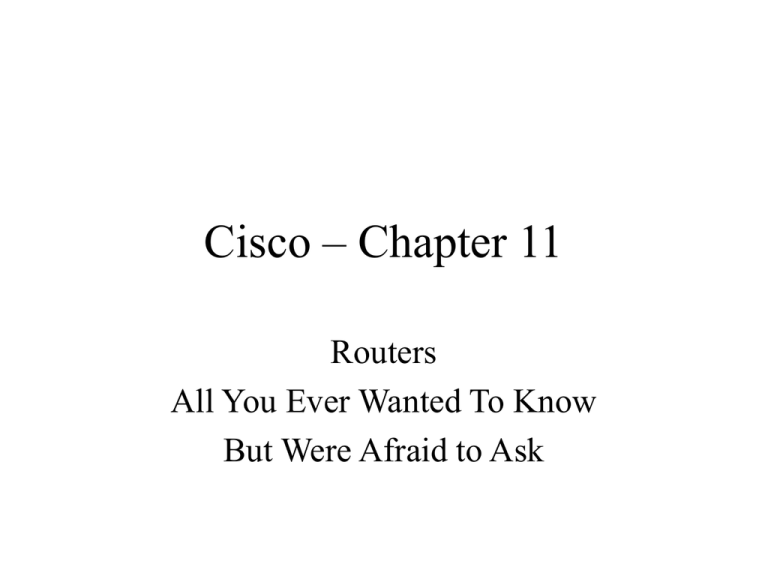
Cisco – Chapter 11 Routers All You Ever Wanted To Know But Were Afraid to Ask Routers – Intelligent Devices • Make best path decisions • Use Layer 3 addresses to make forwarding decisions • Facilitate ARP – Address Resolution Protocol to learn MAC addresses • Facilitate RARP – helping a device learn its IP address • Uses Routing Protocols (determine best path) on Routed Protocols (protocols that can be routed) Review of Layer 2 Devices • Bridges and Switches operate at Layer 2 – Use MAC (Physical) address to filter and forward – Used to connect segments of a network • Routers operate at Layer 3 – Use IP (logical) addresses to forward and switch – Used to connect separate networks and to access WWW – Provide end-to-end routing Router Connections • Router Interfaces must have addresses • Functions Performed – Strips off data link header carried by frame (contains MAC addresses) – Examines network layer addresses (IP) to determine destination network – Consults routing tables to determine which interface (port) to use to forward packet • Each interface requires separate, unique network address – Encapsulates packet into proper frame to route • Token Ring, Ethernet, FDDI, etc. Assigning IP Addresses • Static – Configure each device with IP address • Keep meticulous records – Some operating systems, such as Windows 95 and Windows NT, send an ARP request to check for a duplicate IP address when they attempt to initialize TCP/IP – Generate error message and won’t initialize TCP/IP if they find duplicate IP address Addressing • Dynamic – RARP – Reverse Address Resolution Protocol • Binds MAC address to IP device • Requires RARP server to answer RARP requests • MAC and IP headers and operation code are difference from ARP request • Broadcast goes to all devices on network – BOOTstrap Protocol (BOOTP) • Uses UDP to carry messages; UDP encapsulated in IP datagram • Takes IP address that matches its MAC address – Operates in a client-server environment – Can contain IP address, router address, server address Addressing - DHCP • Dynamic Host Configuration Protocol – Allows host to obtain an IP quickly – Defined range of IP addresses reside on DHCP server – Hosts request address from server – Server chooses address and assigns it – Server can also send subnet mask DHCP Process • Sends CHCPDiscover broadcast message – UDP packets with port number set to BOOTP port – Client moves into select state and collects DCPOFFER responses from server – Client selects first response and negotiates lease time (length of time to keep address without renewing it) by sending DHCPREQUEST packet – Acknowledgement from server enters client into BOUND state ARP Request and ICMP • ARP Address Resolution Protocol – Uses to find IP address when MAC address is known • ICMP (Internet Control Message Protocol) – Used to report a problem to sender of message • E.g. undeliverable packet • Echo request/echo reply - pinging ARP Tables • Contain MAC and IP addresses of devices on same LAN – Map IP address to IP address (in RAM ) • When source host locates entry in its table, it binds or associates the IP address to the MAC address and uses it to encapsulate the data Using ARP to Determine IP Address • If MAC-IP address bond is not in ARP table – Host sends broadcast FF FF FF FF FF FF to all hosts on network segment – If IP address is on segment, host responds by sending its MAC address – ARP Reply • If IP address is not discovered – Gateway IP is used • Router sends ARP using its MAC address Routers and ARP Requests • If Gateway (router) recognizes that IP address is on same subnet as source host, it discards packet • If subnet address is different, router responds with its MAC address (proxy ARP) • Router then sends the ARP request to the proper subnet • If necessary, Router sends ARP request to another router --- INDIRECT ROUTING Routed or Routable Protocols • Protocols that provide support for the network layer • IPX, IP, Appletalk, DecNET • NOT ROUTABLE – NetBEUI – small, fast, efficient, but limited to running on one segment Routing Protocols All Interior • Determine the paths that routed protocols follow to destinations • RIP Routing Information Protocol – Hops • IGRP Cisco – uses several metrics • OSPF Open Shortest Path First • EIGRP Cisco - hybrid Exterior Gateway Protocol - EGP • Used to connect to outside world – Internet – Other networks – BGP – Border Gateway Protocol is primary exterior routing protocol of the Internet RIP • 15 hops is maximum • Belongs to Interior Gateway Protocols – Used only in autonomous networks • Updates routing table every 30 seconds • Create large amounts of network traffic because are constantly connecting to neighboring routers • Uses one metric – distance vector IGRP • Cisco protocol • Distance vector protocol • Uses other metrics as well – – – – Bandwidth Load Delay reliability EIGRP • Enhanced Interior Gateway Routing Protocol • Hybrid of Link-State and Distance Vector – Basic difference is way they update routing tables and metrics used • Provides superior operating efficiency • Combines advantages of link-state protocols and distance vector protocols OSPF • Open Shortest Path First – Determines optimum path – Uses several criteria to determine best route • • • • • Cost Route speed Traffic Reliability Security Encapsulation • If router strips frame header and can’t find destinastion IP address, it may drop the packet Multiple Protocols • Routers can support many routed protocols – – – – – IPX, IP, AppleTalk, DecNet IPX is Novell protocol IP is Internet protocol AppleTalk is Macintosh protocol DecNet is DEC protocol Static Routes • Manual entries in routing tables – – – – Entered by network administrator Can be used to test a link on the network Also used to conserve wide area bandwidth Preferred way when there is only one path to destination network • Referred to as STUB network Dynamic Routing • Eliminates need for network administrators to manually enter information • Works best when bandwidth and large amounts of network traffic are not issues • RIP, IGRP, EIGRP, and OSPF can handle dynamic routing • Internet would be impossible without dynamic routing Connectionless vs Connection Oriented • Connectionless – Destination not contacted before packet is sent • Postal System – Packet Switched • Connection Oriented – Destination contacted before packet is sent • Telephone system – Circuit Switched


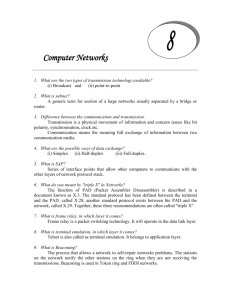

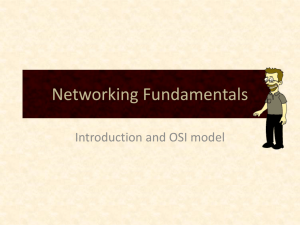
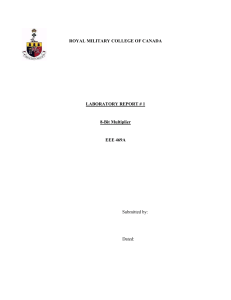
![Internetworking Technologies [Opens in New Window]](http://s3.studylib.net/store/data/007474950_1-04ba8ede092e0c026d6f82bb0c5b9cb6-300x300.png)


